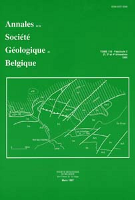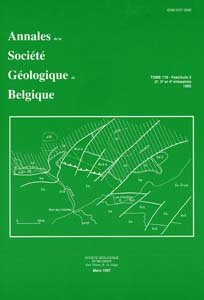- Portada
- Volume 113 (1990)
- Fascicule 2
- Collapse breccias and sedimentary conglomerates in the Lower Visean of the Vesdre area (E-Belgium)
Vista(s): 303 (1 ULiège)
Descargar(s): 1049 (1 ULiège)
Collapse breccias and sedimentary conglomerates in the Lower Visean of the Vesdre area (E-Belgium)

Résumé
Dans le Moliniacien inférieur, deux types de rudites carbonatées ont été distingués dans la carrière de Walhorn. Cette distinction est basée sur une étude minéralogique, lithologique et génétique.
Le premier, situé dans la partie inférieure représente une brèche dolomitique d'effondrement par dissolution d'évaporites. La brèche consiste en cinq «shallowing upward» séquences, qui ont été déposées dans un milieu de type sabkha. Des dolomies pseudomorphes de nodules anhydritiques sont des constituants importants de la brèche.
La partie supérieure de la rudite est principalement formée par un conglomérat d'origine sédimentaire. Cette interprétation est basée sur la présence de grands fragments poligènes arrondis, d'une faune marine et de présence d'oolites dans la matrice. Cette unité conglomératique représente une «shallowing upward» séquence. Les caractéristiques macroscopiques des fragments indiquent que le transport s'est passé dans un milieu énergétique et fut de courte durée. Les processus de transport possibles sont discutés.
Abstract
Based on their lithological and petrographical features two carbonates rudites have been distinguished in the lower part of the Lower Visean (Lower Moliniacian) of the Walhorn quarry.
The lowermost carbonate rudite, the dolomitic Vesdre Breccia Member, is an evaporitic solution-collapse breccia, that consisted primarily of a number of shallowing upward sequences deposited in a sabkha environment. Dolomite pseudomorphs after anhydrite nodules still form a major portion of this breccia.
The upper carbonate rudite is mainly a limestone conglomerate of sedimentary origin. This interpretation is based on the presence of large, rounded, polymict carbonate fragments and the presence of marine biota and oolites in the conglomerate matrix. The conglomerate unit represents a shallowing upward sequence. The macroscopic features of the conglomerate fragments indicate that the transport occurred in a short lived, highly energetic environment. The possible depositional environments are discussed.
Para citar este artículo
Acerca de: Koen Vogel
Fysico-chemische geologie, Katholieke Universiteit Leuven, Celestijnenlaan 200C. B-3001 Heverlee, Belgium ; 447 Deike Building. The Pennsylvania State University, University Park, Pa. 16802, U.S.A.
Acerca de: Philippe Muchez
Fysico-chemische geologie, Katholieke Universiteit Leuven, Celestijnenlaan 200C. B-3001 Heverlee, Belgium ; Senior research assistant N.F.W.O.
Acerca de: Willy Viaene
Fysico-chemische geologie, Katholieke Universiteit Leuven, Celestijnenlaan 200C. B-3001 Heverlee, Belgium.





